Overpopulation in India: A BUSP003 Policy Brief, Autumn 2022
VerifiedAdded on 2023/02/03
|5
|1214
|79
Report
AI Summary
This report is a policy brief addressing the critical issue of overpopulation, particularly focusing on the situation in India. It identifies overpopulation as a social dilemma, where individual self-interest (women having more children) leads to detrimental consequences for society and the environment. The brief examines the economic impacts, including resource depletion, unemployment, high cost of living, and environmental degradation, while also applying game theory to model the interactions. The report suggests potential solutions, such as promoting education, providing financial incentives for women, improving healthcare, and implementing family planning policies. It concludes by emphasizing the urgent need for government intervention and individual responsibility to mitigate the negative effects of overpopulation and ensure sustainable development. The brief includes relevant figures and references to support the analysis.
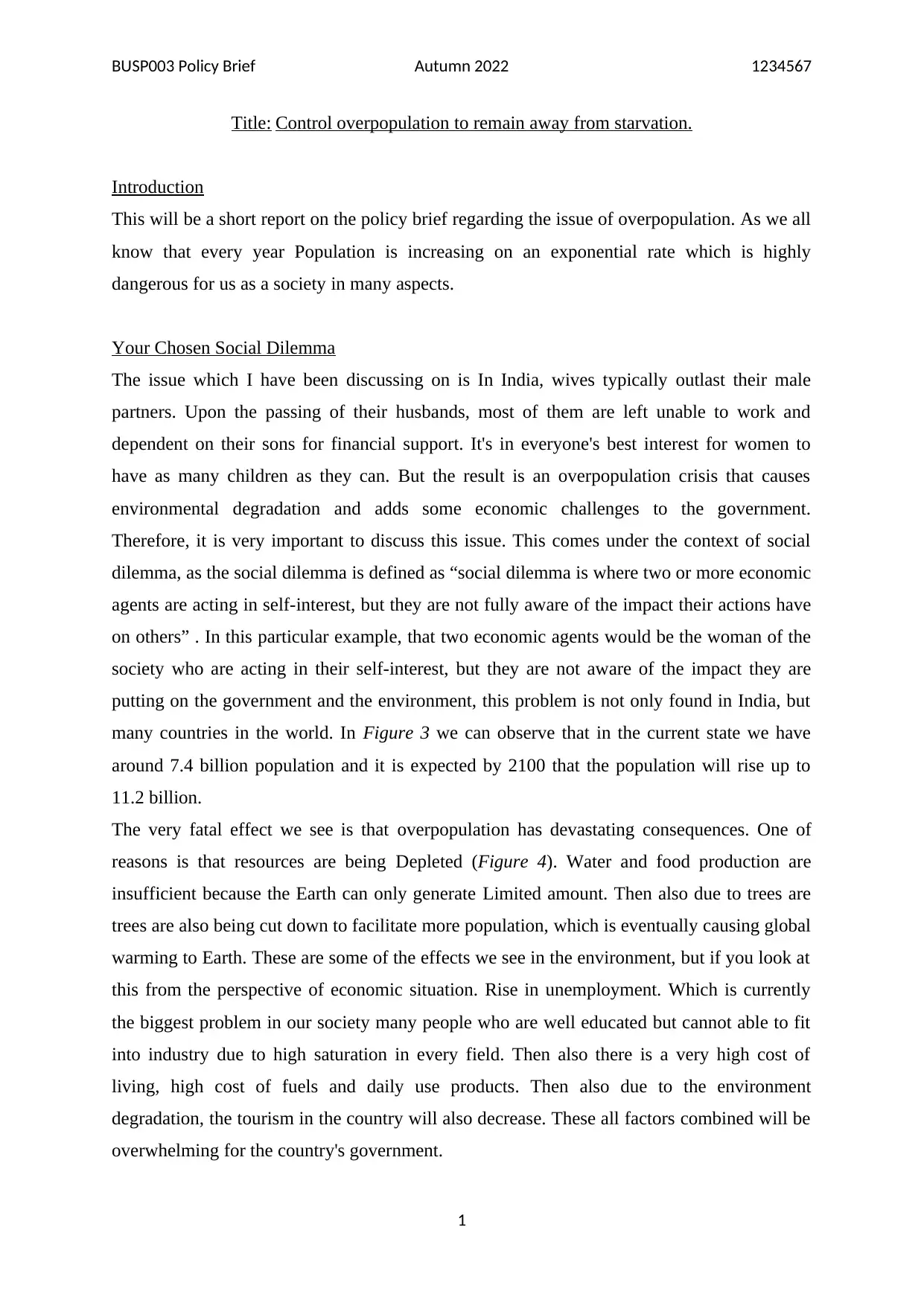
BUSP003 Policy Brief Autumn 2022 1234567
Title: Control overpopulation to remain away from starvation.
Introduction
This will be a short report on the policy brief regarding the issue of overpopulation. As we all
know that every year Population is increasing on an exponential rate which is highly
dangerous for us as a society in many aspects.
Your Chosen Social Dilemma
The issue which I have been discussing on is In India, wives typically outlast their male
partners. Upon the passing of their husbands, most of them are left unable to work and
dependent on their sons for financial support. It's in everyone's best interest for women to
have as many children as they can. But the result is an overpopulation crisis that causes
environmental degradation and adds some economic challenges to the government.
Therefore, it is very important to discuss this issue. This comes under the context of social
dilemma, as the social dilemma is defined as “social dilemma is where two or more economic
agents are acting in self-interest, but they are not fully aware of the impact their actions have
on others” . In this particular example, that two economic agents would be the woman of the
society who are acting in their self-interest, but they are not aware of the impact they are
putting on the government and the environment, this problem is not only found in India, but
many countries in the world. In Figure 3 we can observe that in the current state we have
around 7.4 billion population and it is expected by 2100 that the population will rise up to
11.2 billion.
The very fatal effect we see is that overpopulation has devastating consequences. One of
reasons is that resources are being Depleted (Figure 4). Water and food production are
insufficient because the Earth can only generate Limited amount. Then also due to trees are
trees are also being cut down to facilitate more population, which is eventually causing global
warming to Earth. These are some of the effects we see in the environment, but if you look at
this from the perspective of economic situation. Rise in unemployment. Which is currently
the biggest problem in our society many people who are well educated but cannot able to fit
into industry due to high saturation in every field. Then also there is a very high cost of
living, high cost of fuels and daily use products. Then also due to the environment
degradation, the tourism in the country will also decrease. These all factors combined will be
overwhelming for the country's government.
1
Title: Control overpopulation to remain away from starvation.
Introduction
This will be a short report on the policy brief regarding the issue of overpopulation. As we all
know that every year Population is increasing on an exponential rate which is highly
dangerous for us as a society in many aspects.
Your Chosen Social Dilemma
The issue which I have been discussing on is In India, wives typically outlast their male
partners. Upon the passing of their husbands, most of them are left unable to work and
dependent on their sons for financial support. It's in everyone's best interest for women to
have as many children as they can. But the result is an overpopulation crisis that causes
environmental degradation and adds some economic challenges to the government.
Therefore, it is very important to discuss this issue. This comes under the context of social
dilemma, as the social dilemma is defined as “social dilemma is where two or more economic
agents are acting in self-interest, but they are not fully aware of the impact their actions have
on others” . In this particular example, that two economic agents would be the woman of the
society who are acting in their self-interest, but they are not aware of the impact they are
putting on the government and the environment, this problem is not only found in India, but
many countries in the world. In Figure 3 we can observe that in the current state we have
around 7.4 billion population and it is expected by 2100 that the population will rise up to
11.2 billion.
The very fatal effect we see is that overpopulation has devastating consequences. One of
reasons is that resources are being Depleted (Figure 4). Water and food production are
insufficient because the Earth can only generate Limited amount. Then also due to trees are
trees are also being cut down to facilitate more population, which is eventually causing global
warming to Earth. These are some of the effects we see in the environment, but if you look at
this from the perspective of economic situation. Rise in unemployment. Which is currently
the biggest problem in our society many people who are well educated but cannot able to fit
into industry due to high saturation in every field. Then also there is a very high cost of
living, high cost of fuels and daily use products. Then also due to the environment
degradation, the tourism in the country will also decrease. These all factors combined will be
overwhelming for the country's government.
1
Paraphrase This Document
Need a fresh take? Get an instant paraphrase of this document with our AI Paraphraser
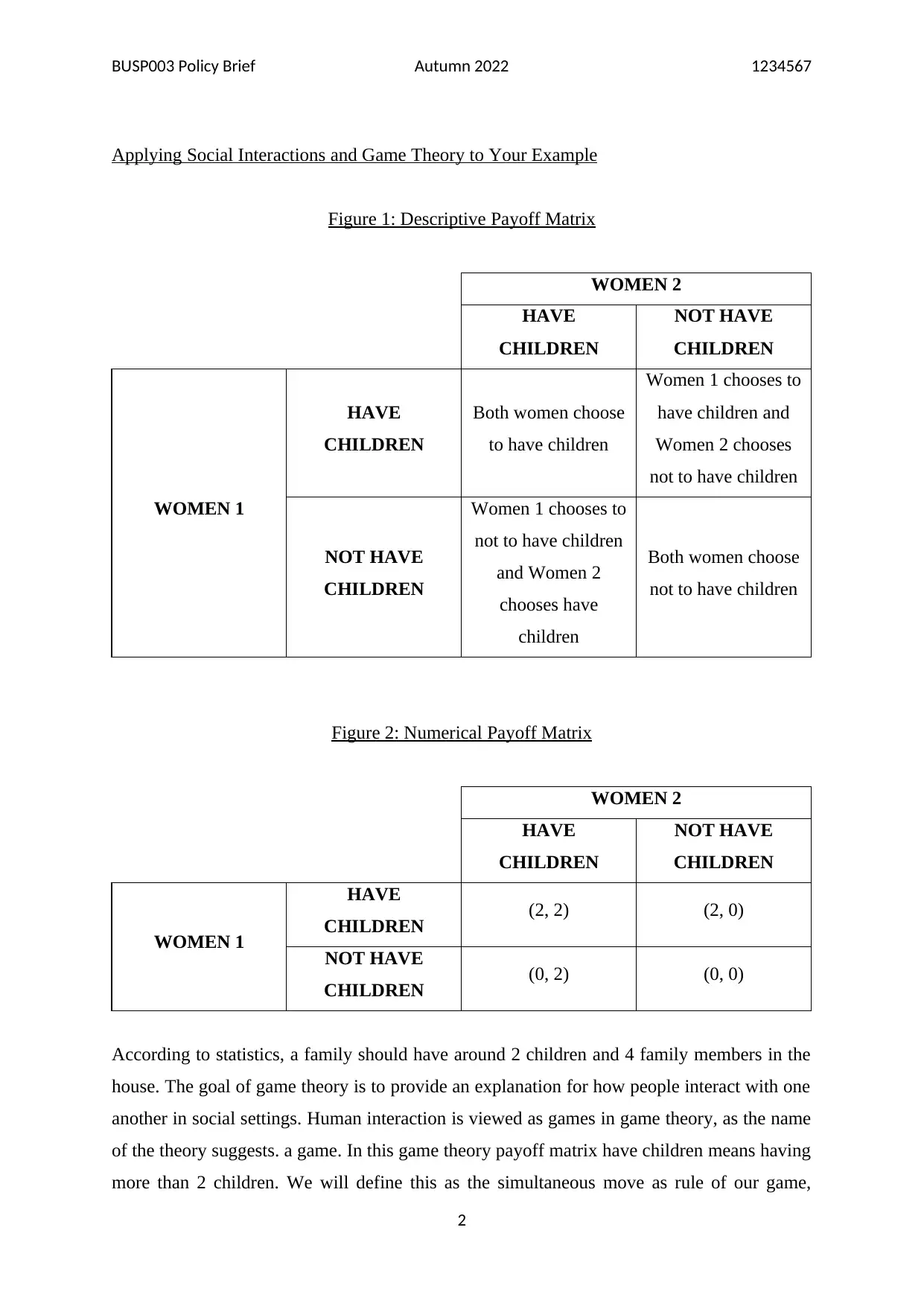
BUSP003 Policy Brief Autumn 2022 1234567
Applying Social Interactions and Game Theory to Your Example
Figure 1: Descriptive Payoff Matrix
WOMEN 2
HAVE
CHILDREN
NOT HAVE
CHILDREN
WOMEN 1
HAVE
CHILDREN
Both women choose
to have children
Women 1 chooses to
have children and
Women 2 chooses
not to have children
NOT HAVE
CHILDREN
Women 1 chooses to
not to have children
and Women 2
chooses have
children
Both women choose
not to have children
Figure 2: Numerical Payoff Matrix
WOMEN 2
HAVE
CHILDREN
NOT HAVE
CHILDREN
WOMEN 1
HAVE
CHILDREN (2, 2) (2, 0)
NOT HAVE
CHILDREN (0, 2) (0, 0)
According to statistics, a family should have around 2 children and 4 family members in the
house. The goal of game theory is to provide an explanation for how people interact with one
another in social settings. Human interaction is viewed as games in game theory, as the name
of the theory suggests. a game. In this game theory payoff matrix have children means having
more than 2 children. We will define this as the simultaneous move as rule of our game,
2
Applying Social Interactions and Game Theory to Your Example
Figure 1: Descriptive Payoff Matrix
WOMEN 2
HAVE
CHILDREN
NOT HAVE
CHILDREN
WOMEN 1
HAVE
CHILDREN
Both women choose
to have children
Women 1 chooses to
have children and
Women 2 chooses
not to have children
NOT HAVE
CHILDREN
Women 1 chooses to
not to have children
and Women 2
chooses have
children
Both women choose
not to have children
Figure 2: Numerical Payoff Matrix
WOMEN 2
HAVE
CHILDREN
NOT HAVE
CHILDREN
WOMEN 1
HAVE
CHILDREN (2, 2) (2, 0)
NOT HAVE
CHILDREN (0, 2) (0, 0)
According to statistics, a family should have around 2 children and 4 family members in the
house. The goal of game theory is to provide an explanation for how people interact with one
another in social settings. Human interaction is viewed as games in game theory, as the name
of the theory suggests. a game. In this game theory payoff matrix have children means having
more than 2 children. We will define this as the simultaneous move as rule of our game,
2
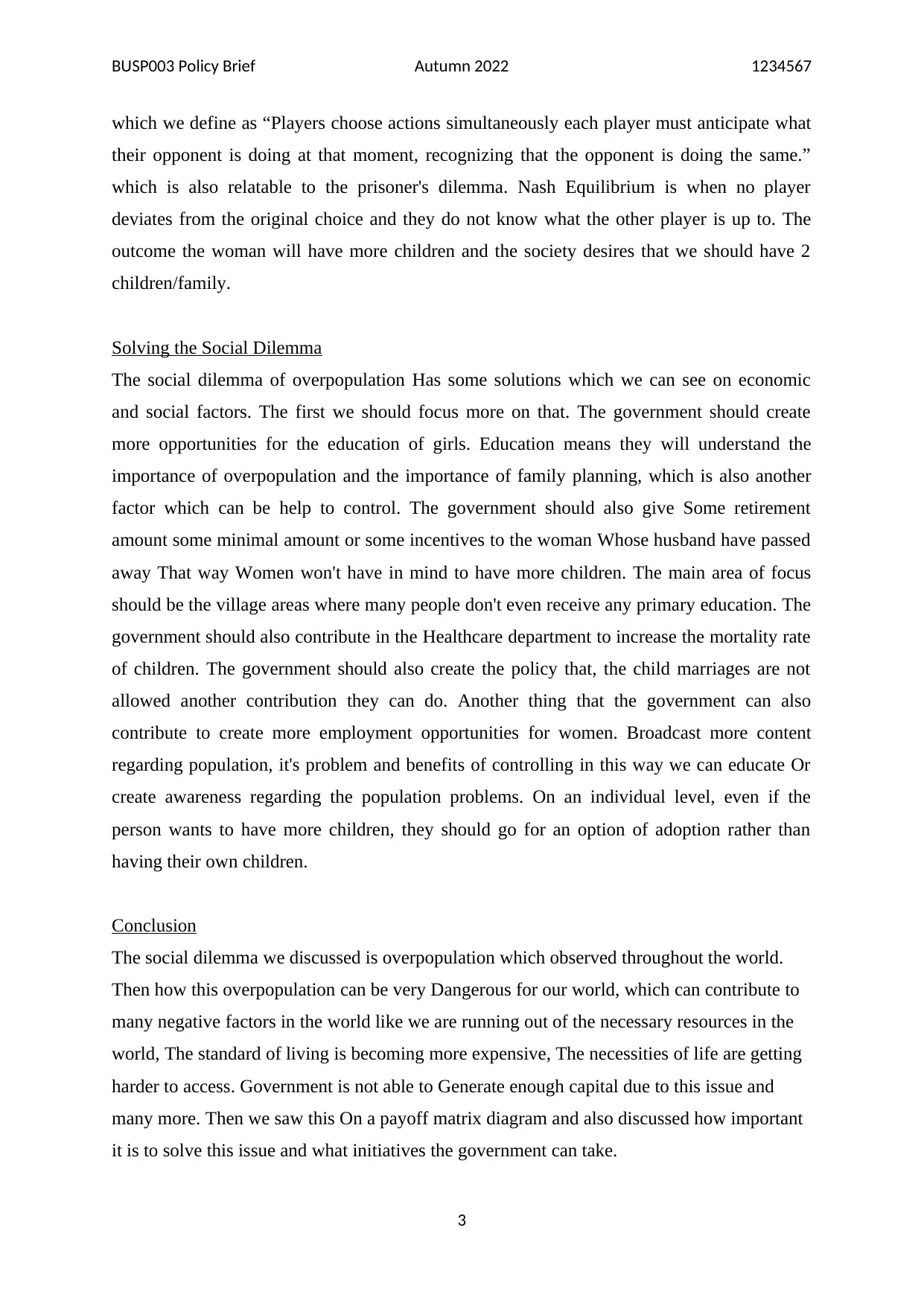
BUSP003 Policy Brief Autumn 2022 1234567
which we define as “Players choose actions simultaneously each player must anticipate what
their opponent is doing at that moment, recognizing that the opponent is doing the same.”
which is also relatable to the prisoner's dilemma. Nash Equilibrium is when no player
deviates from the original choice and they do not know what the other player is up to. The
outcome the woman will have more children and the society desires that we should have 2
children/family.
Solving the Social Dilemma
The social dilemma of overpopulation Has some solutions which we can see on economic
and social factors. The first we should focus more on that. The government should create
more opportunities for the education of girls. Education means they will understand the
importance of overpopulation and the importance of family planning, which is also another
factor which can be help to control. The government should also give Some retirement
amount some minimal amount or some incentives to the woman Whose husband have passed
away That way Women won't have in mind to have more children. The main area of focus
should be the village areas where many people don't even receive any primary education. The
government should also contribute in the Healthcare department to increase the mortality rate
of children. The government should also create the policy that, the child marriages are not
allowed another contribution they can do. Another thing that the government can also
contribute to create more employment opportunities for women. Broadcast more content
regarding population, it's problem and benefits of controlling in this way we can educate Or
create awareness regarding the population problems. On an individual level, even if the
person wants to have more children, they should go for an option of adoption rather than
having their own children.
Conclusion
The social dilemma we discussed is overpopulation which observed throughout the world.
Then how this overpopulation can be very Dangerous for our world, which can contribute to
many negative factors in the world like we are running out of the necessary resources in the
world, The standard of living is becoming more expensive, The necessities of life are getting
harder to access. Government is not able to Generate enough capital due to this issue and
many more. Then we saw this On a payoff matrix diagram and also discussed how important
it is to solve this issue and what initiatives the government can take.
3
which we define as “Players choose actions simultaneously each player must anticipate what
their opponent is doing at that moment, recognizing that the opponent is doing the same.”
which is also relatable to the prisoner's dilemma. Nash Equilibrium is when no player
deviates from the original choice and they do not know what the other player is up to. The
outcome the woman will have more children and the society desires that we should have 2
children/family.
Solving the Social Dilemma
The social dilemma of overpopulation Has some solutions which we can see on economic
and social factors. The first we should focus more on that. The government should create
more opportunities for the education of girls. Education means they will understand the
importance of overpopulation and the importance of family planning, which is also another
factor which can be help to control. The government should also give Some retirement
amount some minimal amount or some incentives to the woman Whose husband have passed
away That way Women won't have in mind to have more children. The main area of focus
should be the village areas where many people don't even receive any primary education. The
government should also contribute in the Healthcare department to increase the mortality rate
of children. The government should also create the policy that, the child marriages are not
allowed another contribution they can do. Another thing that the government can also
contribute to create more employment opportunities for women. Broadcast more content
regarding population, it's problem and benefits of controlling in this way we can educate Or
create awareness regarding the population problems. On an individual level, even if the
person wants to have more children, they should go for an option of adoption rather than
having their own children.
Conclusion
The social dilemma we discussed is overpopulation which observed throughout the world.
Then how this overpopulation can be very Dangerous for our world, which can contribute to
many negative factors in the world like we are running out of the necessary resources in the
world, The standard of living is becoming more expensive, The necessities of life are getting
harder to access. Government is not able to Generate enough capital due to this issue and
many more. Then we saw this On a payoff matrix diagram and also discussed how important
it is to solve this issue and what initiatives the government can take.
3
⊘ This is a preview!⊘
Do you want full access?
Subscribe today to unlock all pages.

Trusted by 1+ million students worldwide
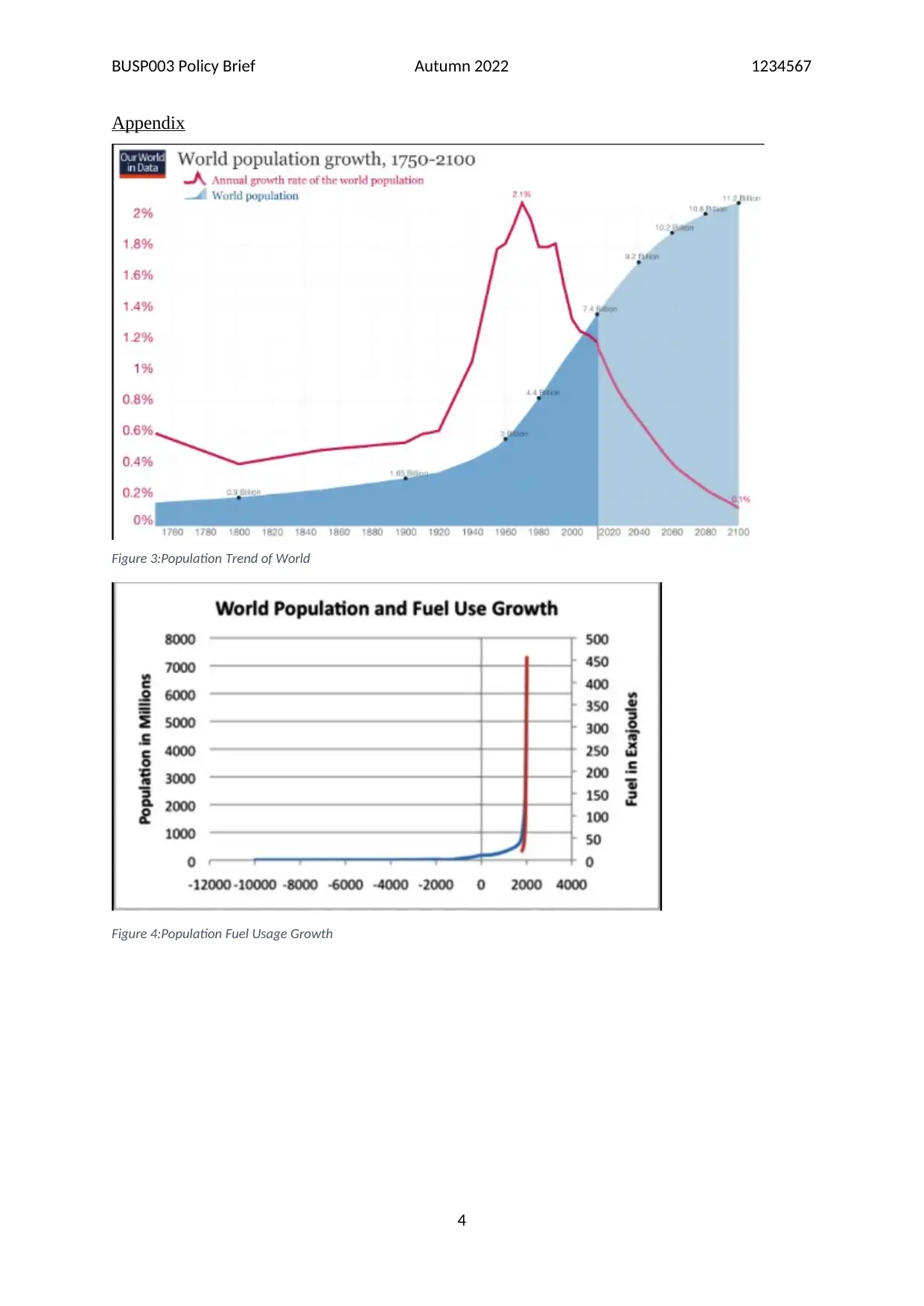
BUSP003 Policy Brief Autumn 2022 1234567
Appendix
Figure 3:Population Trend of World
Figure 4:Population Fuel Usage Growth
4
Appendix
Figure 3:Population Trend of World
Figure 4:Population Fuel Usage Growth
4
Paraphrase This Document
Need a fresh take? Get an instant paraphrase of this document with our AI Paraphraser
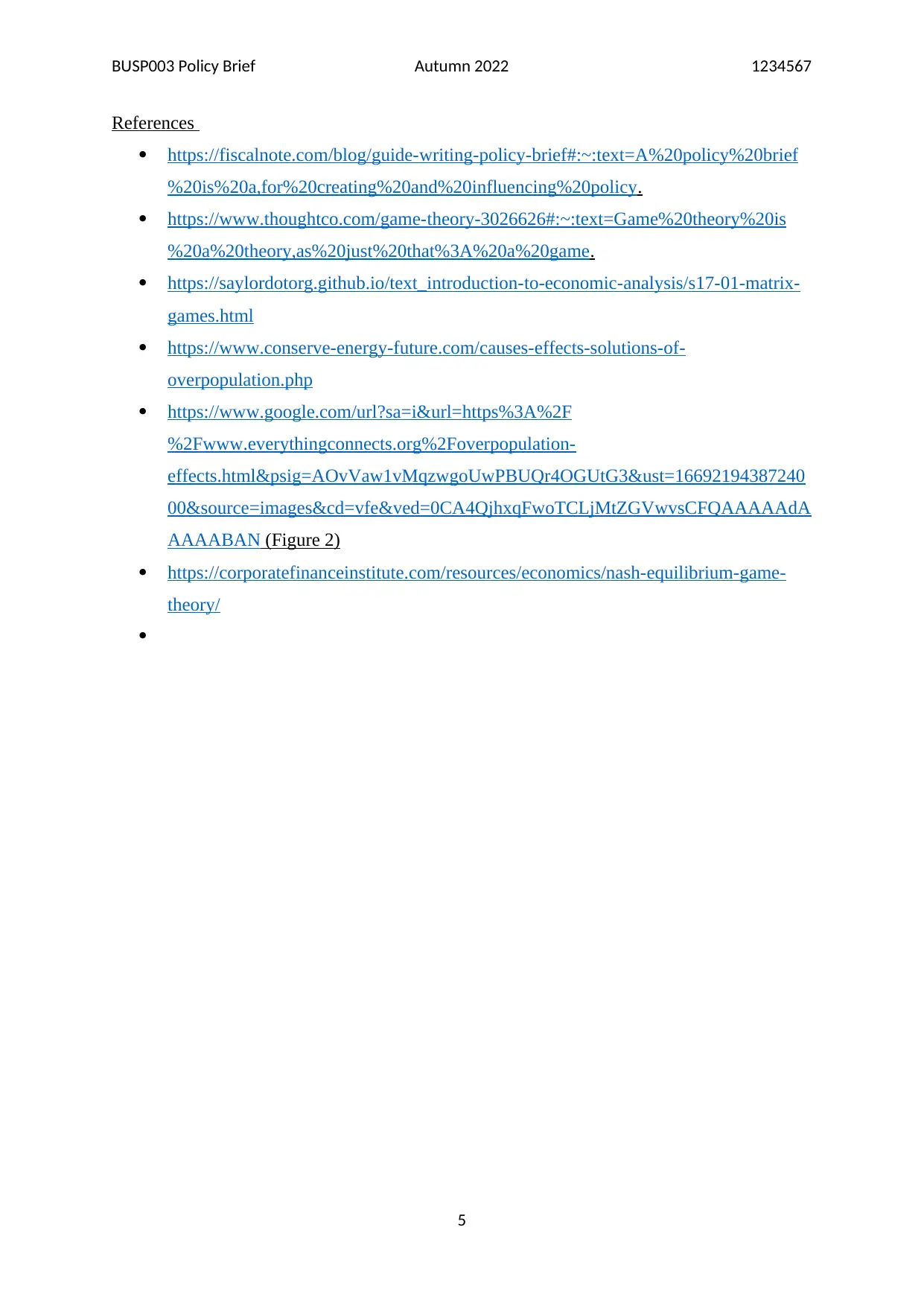
BUSP003 Policy Brief Autumn 2022 1234567
References
https://fiscalnote.com/blog/guide-writing-policy-brief#:~:text=A%20policy%20brief
%20is%20a,for%20creating%20and%20influencing%20policy.
https://www.thoughtco.com/game-theory-3026626#:~:text=Game%20theory%20is
%20a%20theory,as%20just%20that%3A%20a%20game.
https://saylordotorg.github.io/text_introduction-to-economic-analysis/s17-01-matrix-
games.html
https://www.conserve-energy-future.com/causes-effects-solutions-of-
overpopulation.php
https://www.google.com/url?sa=i&url=https%3A%2F
%2Fwww.everythingconnects.org%2Foverpopulation-
effects.html&psig=AOvVaw1vMqzwgoUwPBUQr4OGUtG3&ust=16692194387240
00&source=images&cd=vfe&ved=0CA4QjhxqFwoTCLjMtZGVwvsCFQAAAAAdA
AAAABAN (Figure 2)
https://corporatefinanceinstitute.com/resources/economics/nash-equilibrium-game-
theory/
5
References
https://fiscalnote.com/blog/guide-writing-policy-brief#:~:text=A%20policy%20brief
%20is%20a,for%20creating%20and%20influencing%20policy.
https://www.thoughtco.com/game-theory-3026626#:~:text=Game%20theory%20is
%20a%20theory,as%20just%20that%3A%20a%20game.
https://saylordotorg.github.io/text_introduction-to-economic-analysis/s17-01-matrix-
games.html
https://www.conserve-energy-future.com/causes-effects-solutions-of-
overpopulation.php
https://www.google.com/url?sa=i&url=https%3A%2F
%2Fwww.everythingconnects.org%2Foverpopulation-
effects.html&psig=AOvVaw1vMqzwgoUwPBUQr4OGUtG3&ust=16692194387240
00&source=images&cd=vfe&ved=0CA4QjhxqFwoTCLjMtZGVwvsCFQAAAAAdA
AAAABAN (Figure 2)
https://corporatefinanceinstitute.com/resources/economics/nash-equilibrium-game-
theory/
5
1 out of 5
Your All-in-One AI-Powered Toolkit for Academic Success.
+13062052269
info@desklib.com
Available 24*7 on WhatsApp / Email
![[object Object]](/_next/static/media/star-bottom.7253800d.svg)
Unlock your academic potential
Copyright © 2020–2025 A2Z Services. All Rights Reserved. Developed and managed by ZUCOL.

